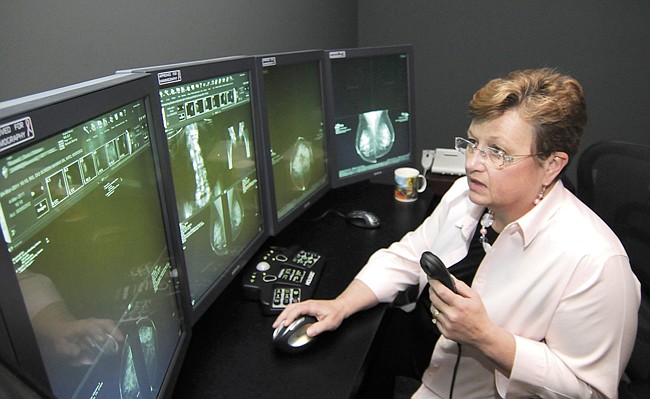COVER STORY-Experts debate value of routine screenings
Guidelines released in 2009 suggesting some screening tests are overused provoked a backlash locally among breast cancer survivors, advocacy groups promoting screenings and some patients.
The U.S. Preventive Services Task Force recommended that women with no family history or other risk factors begin getting mammograms at 50 instead of 40, and every two years instead of every one or two years.
The group also said women over 74 could skip mammograms because they most likely would die of other causes before breast cancer - usually slow-growing in older women - would ever become a problem.
"The one thing that seemed to be tried and true for women is their annual mammogram and annual [Pap smears]," said Dr. Patricia McLelland, Chattanooga obstetrician-gynecologist. "What you're asking them to do is make a paradigm shift."
The reaction was quick and harsh from radiologists, breast cancer survivors and advocacy groups.
"They should have realized that was going to cause a brouhaha," said Dr. Ken Patric, primary care specialist and former chief medical officer for BlueCross BlueShield of Tennessee.
The American Cancer Society has not changed its recommendation that women 40 and older should have annual mammograms.
Some health care reform critics cited the task force's recommendations as warning about government rationing of care predicted under reform.
"These new recommendations seem to reflect a conscious decision to ration care," Carol Lee, chairwoman of the American College of Radiology Breast Imaging Commission, said after the recommendations were announced.
"These unfounded USPSTF recommendations ignore the valid scientific data and place a great many women at risk of dying unnecessarily from a disease that we have made significant headway against over the past 20 years."
Dr. Bruce Calonge, president and CEO of The Colorado Trust and chairman of the U.S. Preventive Services Task Force, said the task force expected the recommendations would be linked to health care reform, even though they were approved about six months before President Barack Obama was elected.
The task force is an independent panel of private-sector experts in evidence-based preventive medicine. It is funded by the federal Agency for Healthcare Research and Quality.
Calonge said the recommendations didn't mean to say women shouldn't get mammograms before 50 if they want them, nor that insurance companies shouldn't cover them.
But he said the recommendations reflect research showing routine screenings for women in their 40s provide a minimal benefit compared to the risks.
"We're working hard on our messaging," he said.
Still, opponents worry that insurance companies will tie coverage to the recommendations, limiting options for patients who want more screenings.
The health care reform law mandates that insurance companies, at a minimum, cover the preventive care services recommended by the task force.
Dr. Laura Witherspoon, a breast surgeon with University Surgical Associates in Chattanooga, said she understands advising against mammograms for women over 74 because there's no evidence they save lives and they could cause anxiety and discomfort without any benefit.
But that doesn't mean Witherspoon wouldn't conduct the test on a robust 82-year-old woman who wants it.
"They're not some fly-by-night organization that made all this stuff up. They're basing their conclusions on data. But are their conclusions about it the same as mine? Maybe not," she said.
Dartmouth researcher Gil Welch said the downside to screening has been completely underplayed.
"We've systematically exaggerated the benefits of early detection and we've downplayed or ignored entirely the harms," he said. "Our concern is that people ought to know both sides of the story. We're not saying you shouldn't be tested. [We're saying] these are genuine choices."
About 2,500 50-year-old women would have to get mammographies for 10 years to prevent one breast cancer death, said Welch, author of "Overdiagnosed: Making People Sick in the Pursuit of Health," released this year. Welch is a professor at Dartmouth's Institute for Health Policy and Clinical Practice.
Of the remaining 2,499 women, almost half will have abnormal mammograms and half of them will have biopsies. Between five and 15 will be treated with surgery or chemotherapy for a cancer that never would have hurt them, he said.
PROSTATE CANCER SCREENING QUESTIONED
Two studies in 2009 questioned the value of prostate cancer screenings. An American study found death rates were not reduced among men who had an annual PSA blood test. A European study found that for every death prevented by PSA screening, 48 men were treated unnecessarily for prostate cancer.
Blood screenings can show elevated PSA - prostate-specific antigen - levels that could indicate cancer, but also can lead to unnecessary treatments with serious, life-altering side effects, including erectile dysfunction and incontinence.
"They haven't been able to demonstrate whether it saves lives," said Dr. Lisa Staton, program director for the internal medicine residency program at the University of Tennessee College of Medicine in Chattanooga. "We have different opinions even among our own staff. ... We really do have to individualize it among the patients."
Yet some worry about cutting back on PSAs on black men, who are more than twice as likely to die from prostate cancer as white men, according to the National Cancer Institute.
The Southside and Dodson Avenue community health centers, which treat underserved and low-income people, promote free PSA screenings to address that disproportion.
Staton worries that questioning the value of the screenings could undermine efforts to address those racial disparities in prostate cancer outcomes.
"It's a slippery slope," she said.
